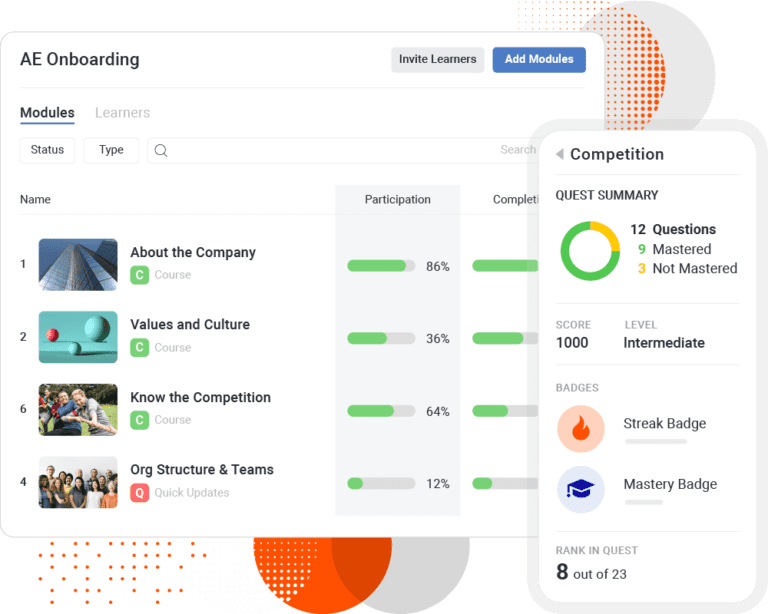“Knowledge is power.” It may be cliche, but it’s true.
Sure, every organization aims to hire the most qualified candidates. However, enterprise learning ensures employees can easily access learning and development opportunities to grow their skills and knowledge.
Organizations that embrace it reap some significant benefits.
Employees are better equipped to do their jobs and grow their skills by implementing enterprise learning. This increases employee engagement, satisfaction, and retention – not to mention the organization’s overall performance.
But what exactly is it?
In this post, we’ll explore the basics of enterprise learning to help you understand:
- What it and why it’s important
- Some of the top benefits
- Some of the key challenges
- The importance of choosing the right solution
What is enterprise learning?
You’re certainly not alone if you’re unsure what enterprise learning is. Let’s examine it and why it matters.
Enterprise learning, defined
Traditional professional learning often involves training built around a specific topic. For example, reps may attend a live rep sales training to get up to speed on a new product offering. Or, employees may be required to attend cybersecurity training within a certain window of time.
It goes beyond traditional training.
Enterprise learning is a set of practices and principles focused on providing employees with easy access to ongoing learning and development opportunities – whenever and wherever they need them. With this type of learning, employees are empowered to sharpen their existing skills and develop new ones that will help take their careers to the next level.
Enterprise learning isn’t a one-time training or event. Instead, it involves providing continuous opportunities across the organizations. In addition, it’s on-demand. Employees can access the resources they need whenever and wherever they need them.
Traditional training may be one component of an enterprise learning program. However, it’s is a holistic practice that may include many other components, like:
- Live and on-demand webinars
- Bite-sized learning
- Text-based resources
- Practice opportunities, like assessments and role-plays
- Sales coaching
- Mentorship
- Knowledge sharing
- Social learning opportunities
- Professional certifications
Why is enterprise learning important?
So, why is it management so important?
Traditional training has a role to play. But on its own, it’s not enough to bolster knowledge and skills. After all, according to Ebbinghaus’s forgetting curve, employees forget 50% of all new information within a day and 90% within a week.
Employees forget
Organizations must build a culture of ongoing learning if they expect to grow and develop their employees effectively – and reap the benefits of doing so. That’s where enterprise learning comes in.
We’ll take a closer look at some of the key benefits next.
6 key benefits of enterprise learning
Increasingly, organizations are shifting from traditional training to an enterprise learning approach. This makes sense, as both organizations and employees benefit significantly.
While this learning offers numerous benefits, let’s examine six that top the list.
On-demand learning opportunities
In the past, employee training was offered only at a specific time. For example, a sales rep might be required to attend a half-day training session on a new sales methodology.
Of course, real-time training still has a role. However, with enterprise learning, employees can also access learning opportunities on demand.
For example, they can watch an on-demand webinar during their lunch break or squeeze in a bite-sized learning session in the 15 minutes between two meetings.
In other words, employees can seek out upskilling opportunities whenever it work for their schedule. And if it works for their schedule, employees are more likely to do it.
A single source of truth for everything related to learning
Employees might want learning opportunities. But they’re not exactly sure where to find them. That means they waste time hunting for the right materials, which takes away time they could learn.
Organizations that are most successful provide their employees with a single source of truth for everything related to learning. Employees can find everything – from written content to video training to opportunities for social learning – all in one location.
The right management system makes learning materials well-organized and easy to search. Furthermore, employees can always be sure they’re accessing the most up-to-date versions of materials.
That way, employees can spend less time hunting for learning materials and more time learning and bolstering skills.
Improved job and organizational performance
Improved job performance is perhaps one of the most obvious benefits of an enterprise learning approach.
When employees have opportunities to learn and develop new skills, they’re better equipped to do their jobs well. When all employees have these opportunities, job performance across the entire organization will be boosted.
Higher employee satisfaction and retention
Employees who feel supported with ongoing learning opportunities are more satisfied in their roles. Research tells us 68% of employees feel learning opportunities are key to job satisfaction.
Satisfied employees are more likely to stick around long-term. That means you won’t have to deal with the inconvenience and costs of backfilling vacant roles – or the stress of figuring out how to accomplish the same amount of work with a smaller headcount.
A competitive edge
In today’s world, change is inevitable. Your employees may be equipped to tackle their jobs today. However, an enterprise learning approach provides employees with ongoing learning opportunities that’ll help them adapt to continuous change – and excel in their roles. Your organization’s ability to adapt to change will give you a competitive edge.
Powerful insights to optimize learning initiatives
In the past, the HR, training, or enterprise sales enablement team would develop training, distribute it widely, and hope for the best. Though teams would spend plenty of time developing programs, they had little insight into whether their efforts had an impact.
A strong enterprise learning strategy – coupled with the right enterprise software – enables you to measure the impact of your initiatives. For starters, you can see which resources are used. For example, you can see what portion of sellers are accessing specific sales onboarding modules.

You can also understand how the consumption of different learning materials impacts outcomes. For example, you can see whether sellers who complete certain sales training are more likely to reach quota. Or, you can see if other materials are correlated with promotions.
These powerful insights can optimize existing enterprise learning resources, create new ones, and eliminate those that aren’t being used or have the intended impact.
Top challenges of enterprise learning
Organizations that adopt an enterprise learning mindset experience several key benefits. However, it also presents some unique challenges.
Let’s examine some of the top challenges.
#1 Creating engaging content
Different employees have different learning styles. While some prefer video, others are better able to retain written materials. Enterprise learning teams must be able to provide a large volume of assets that’ll resonate with different employees.
Of course, creating these materials takes time. Yet, time is a limited resource.
The good news is that the right tools can help teams develop materials more quickly and easily. One way these tools expedite learning creation is by offering templates as a starting point.
A recent analysis of Mindtickle users found that, on average, it takes between three and four weeks to launch a new enterprise sales enablement program from scratch. However, a program template can dramatically shorten this time to seven days.
Time to launch a program
Then, you can leverage analytics in your enterprise earning platform to determine which types of resources employees use and whether they impact outcomes. You can use this intel to invest in the resources being used and make an impact.
#2 Delivering personalized learning at scale
Learning isn’t one-size-fits-all. Instead, it’s important to offer personalized learning and development opportunities that meet the needs and interests of each employee.
This can be hard to do – especially at large organizations with many different departments.
A platform makes it easier to understand each employee’s unique strengths and weaknesses – and then deliver learning suggestions that meet their needs.
#3 Measuring enterprise learning impact
Many organizations measure the completion of initiatives. For example, they can see what percentage of sales reps completed a specific enterprise sales enablement program.
However, it’s critical also to measure the impact of your initiative. In other words, how is your practice improving outcomes?
This can be tough to understand – especially if you’re using a traditional learning management system (LMS).
However, you can measure consumption and impact with an enterprise learning or revenue enablement platform.
For example, you can see that a specific piece of content is used often – and it’s tied to many closed won deals. You can use these insights to optimize the content further.
#4 Choosing the right enterprise learning technology
Technology is a key component of any strategy. But there are many options, from traditional enterprise LMSs to enterprise revenue enablement platforms and everything in between.
Determining which option is the right fit for your organization’s needs can be challenging.
There’s no right answer. It’s important to consider your needs and find the platform that addresses them.
#5 Increasing adoption
Your initiative won’t impact if no one engages with the resources you offer. But getting employees to take advantage of learning materials can be hard when they already have busy schedules.
Building a learning culture within your organization is the key to combating this challenge. Help employees understand that enterprise learning is beneficial to them. Set aside a day every month when your employees are encouraged to engage with different learning initiatives. Also, provide recognition for those who are leveraging your materials.
Another key way to increase adoption is to rethink the format of your learning materials. Traditional employee training is often dull and lengthy, and employees must set aside a significant chunk of time to complete it.
Instead, consider creating bite-sized learning that employees can engage with when they have a few moments to spare. Be sure to communicate that learning doesn’t have to be a huge investment in time!
Transform enterprise learning with Mindtickle
The right enterprise learning software is foundational to the success of your strategy. But, as mentioned earlier, knowing which solution is the best for your needs can be challenging.
Today, some organizations leverage a traditional learning management system (LMS) to power their enterprise learning programs. However, many enterprise LMSs simply aren’t built for the needs of today’s learners.
Increasingly, organizations are searching for a solution that enables them to develop and deliver personalized learning programs for each employee. Many are opting for an integrated revenue enablement platform like Mindtickle.
With Mindtickle, teams can develop and deliver training and other learning opportunities quickly and easily. That means employees can easily find everything related to enterprise learning – including rep training, content, and coaching – whenever and wherever they need it.
Finally, Mindtickle offers robust data and analytics to help you understand who is engaging with what resources and how that engagement is (or isn’t) impacting performance and outcomes. Then, you can use these insights to optimize your strategy.
Enterprise Learning with Mindtickle
Ready to see firsthand how Mindtickle can help you take your enterprise learning initiative to the next level?
Get Your Demo


 By Helen Waite
By Helen Waite
 By Christian Pieper
By Christian Pieper
